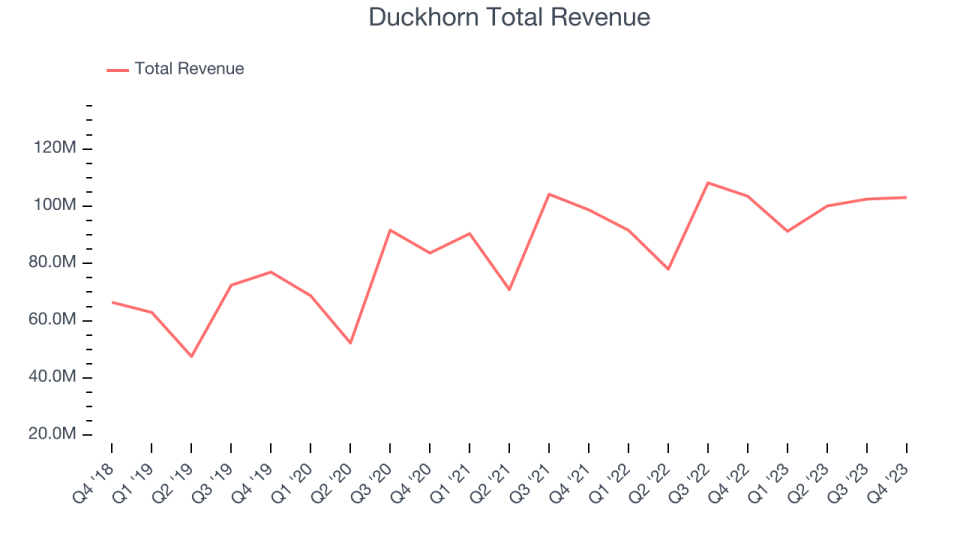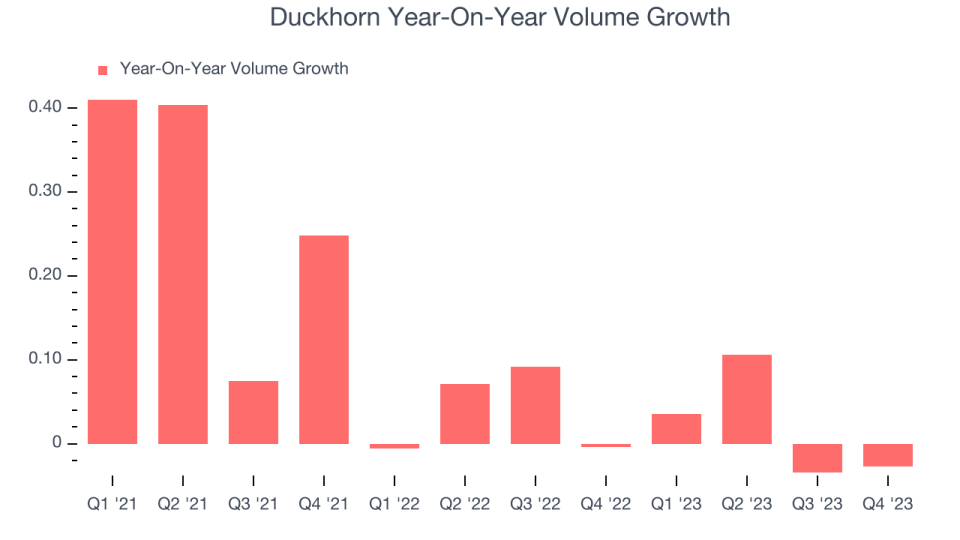Duckhorn (NYSE:NAPA) Misses Q2 Sales Targets

Wine company The Duckhorn Portfolio (NYSE:NAPA) fell short of analysts' expectations in Q2 FY2024, with revenue flat year on year at $103 million. The company's full-year revenue guidance of $403 million at the midpoint also came in 4.5% below analysts' estimates. It made a non-GAAP profit of $0.18 per share, down from its profit of $0.18 per share in the same quarter last year.
Is now the time to buy Duckhorn? Find out by accessing our full research report, it's free.
Duckhorn (NAPA) Q2 FY2024 Highlights:
Revenue: $103 million vs analyst estimates of $105.1 million (2% miss)
EPS (non-GAAP): $0.18 vs analyst expectations of $0.18 (1.4% miss)
The company dropped its revenue guidance for the full year from $423.5 million to $403 million at the midpoint, a 4.8% decrease
Free Cash Flow was -$50.66 million, down from $7.67 million in the previous quarter
Gross Margin (GAAP): 56.6%, up from 53.4% in the same quarter last year
Sales Volumes were down 2.7% year on year
Market Capitalization: $1.07 billion
Deirdre Mahlan, Interim President, Chief Executive Officer and Chairperson, commented, “We delivered strong profitability in the second quarter and continued to take share amidst broader industry headwinds. Importantly, we grew adjusted EBITDA by approximately 10% to $42.7 million representing a 41.5% adjusted EBITDA margin, a 400-basis point improvement over the prior year period, driven by robust gross margins and strong operating cost management.”
With many of their grapes sourced from the famous Napa Valley region of California, The Duckhorn Portfolio (NYSE:NAPA) is a producer of premium wines and known for its Merlot and other Bordeaux varietals.
Beverages and Alcohol
These companies' performance is influenced by brand strength, marketing strategies, and shifts in consumer preferences. Changing consumption patterns are particularly relevant and can be seen in the explosion of alcoholic craft beer drinks or the steady decline of non-alcoholic sugary sodas. Companies that spend on innovation to meet consumers where they are with regards to trends can reap huge demand benefits while those who ignore trends can see stagnant volumes. Finally, with the advent of the social media, the cost of starting a brand from scratch is much lower, meaning that new entrants can chip away at the market shares of established players.
Sales Growth
Duckhorn is a small consumer staples company, which sometimes brings disadvantages compared to larger competitors benefitting from better brand awareness and economies of scale.
As you can see below, the company's annualized revenue growth rate of 10.2% over the last three years was decent for a consumer staples business.

This quarter, Duckhorn missed Wall Street's estimates and reported a rather uninspiring 0.4% year-on-year revenue decline, generating $103 million in revenue. Looking ahead, Wall Street expects sales to grow 10.2% over the next 12 months, an acceleration from this quarter.
Unless you’ve been living under a rock, it should be obvious by now that generative AI is going to have a huge impact on how large corporations do business. While Nvidia and AMD are trading close to all-time highs, we prefer a lesser-known (but still profitable) semiconductor stock benefitting from the rise of AI. Click here to access our free report on our favorite semiconductor growth story.
Volume Growth
Revenue growth can be broken down into changes in price and volume (the number of units sold). While both are important, volume is the lifeblood of a successful staples business as there’s a ceiling to what consumers will pay for everyday goods; they can always trade down to non-branded products if the branded versions are too expensive.
Duckhorn's average quarterly volume growth was a healthy 2.9% over the last two years. This is pleasing because it shows consumers are purchasing more of its products.

In Duckhorn's Q2 2024, sales volumes dropped 2.7% year on year. This result was a further deceleration from the 0.4% year-on-year decline it posted 12 months ago, showing the business is struggling to push its products.
Key Takeaways from Duckhorn's Q2 Results
We enjoyed seeing Duckhorn exceed analysts' gross margin and adjusted EBITDA expectations this quarter. Sadly, that's where the good news ends. Its revenue missed Wall Street's projections as its sales volumes declined 2.7% year on year (analysts were expecting 1.4% growth). Management noted that despite its volume declines, it gained market share as the broader wine industry faced headwinds.
Given the choppy industry backdrop, management lowered its full-year guidance. Sales are now forecasted to be $403 million at the midpoint vs estimates of $422 million. Its adjusted EBITDA and EPS outlook weren't spared either.
Overall, this was a mixed quarter for Duckhorn. The company is down 3.6% on the results and currently trades at $9.11 per share.
Duckhorn may have had a tough quarter, but does that actually create an opportunity to invest right now? When making that decision, it's important to consider its valuation, business qualities, as well as what has happened in the latest quarter. We cover that in our actionable full research report which you can read here, it's free.
